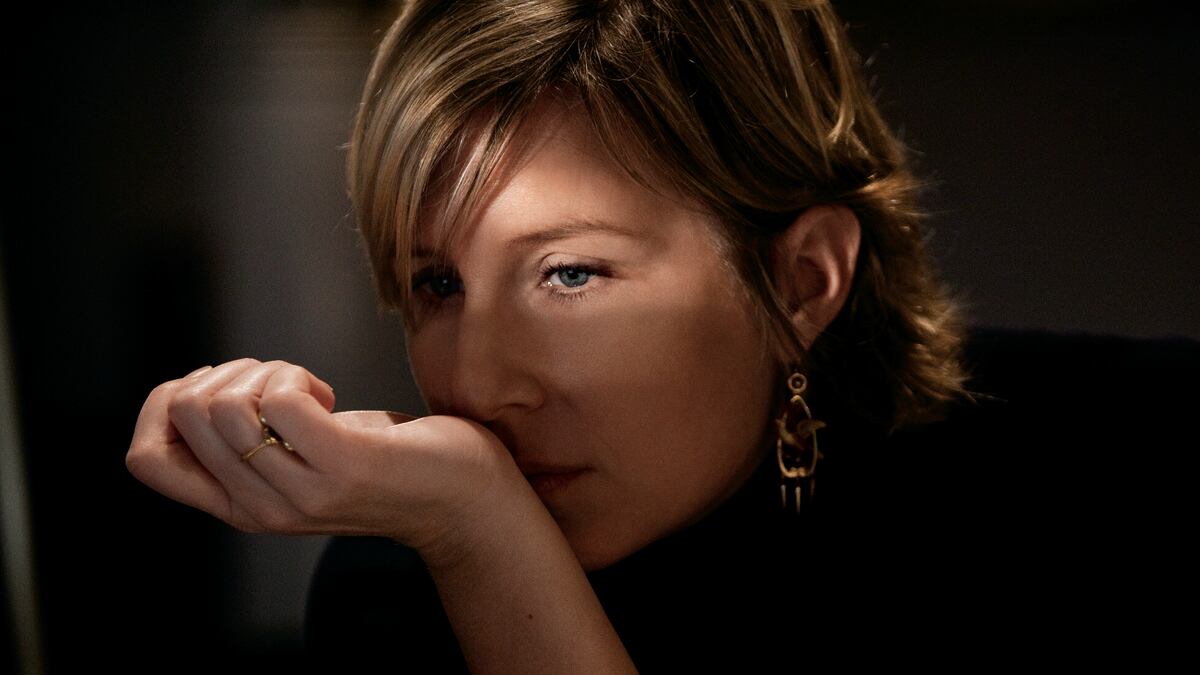In a drab meeting room at the Museum of Arts and Design in New York, Chandler Burr, the world’s only curator of olfactory art, takes out a bottle and spritzes a thin strip of paper. He invites this art critic to take a sniff.
“What do you think?” he asks, leaning forward. The strip smells like … perfume. A bit sharper, maybe, than all the other strips that have been sampled this October morning, but still … perfume. Or maybe fancy soap.
Wrong answer. Burr says he smells a distant hint of rose, but also metal and blood. “Sometimes when I floss, there’s blood, and I hate the taste—it’s awful.”
The fragrance is called Eau de protection, Burr explains, and it is “one of the most fascinating works ever created, in any art form.” It was designed as “a portrait of a woman who is so beautiful that rose runs in her blood. And a man comes with a metal knife, and plunges it into her heart. And it is the smell of her blood, running down the blade.”
He suggests another sniff. Okay, this time the rose becomes clear. But still no metal—maybe a touch of steely astringency—and certainly no blood. Still basically perfume, if maybe a perfume that’s rather different from others. “It’s weird! It’s strange!” Burr insists. “If an alarm bell doesn’t go off when you smell this, you have a neurological problem.” Or maybe you’re just an untutored philistine of fragrance, as impervious to scent’s subtleties as a perfumer might be to the difference between, say, synthetic and analytic cubism.
Burr is only weeks away from his first show (or is it his first “sniff”?), which opens at MAD on Nov. 13. And here he is, this pioneer in scent art, confronted once again by his obvious challenge: How to get even dedicated aesthetes, untrained in the ways of the nose, to get as much as he does from smells.
In The Art of Scent: 1889-2012, Burr will be introducing museum visitors to 12 highpoints in the history of fragrance, thanks to diffusion technology that releases perfume in minute puffs. But it’s still not clear how much of his audience will recognize the art form’s finer points. Holly Hotchner, MAD’s director, heads up a museum devoted to crossovers—to bridging craft and design and fine arts of every kind. But even she sees the show she supports as a gamble: “This is probably as far afield as we’ve gone, in terms of experimentation, because people aren’t used to using their noses.” Burr’s determined to change that, nostril by nostril. (He says we only smell through one at a time.)

Burr recalls how he’d always thought “a painting is a painting,” until an accidental encounter with a connoisseur showed him how much a trained eye could unpack from a single van Gogh. “It was a huge shock to me that he saw a hundred times more in this painting than I did,” Burr says. “It’s exactly the same thing with smell.” He insists that a perfume expert like him isn’t some “biological freak” born with a better nose—any more than art critics are born with better vision—but that he merely uses his more often, and more carefully.
“All knowledge is based on comparison,” Burr says, echoing a professor he once had in Paris. He utters the aphorism in immaculate French, and judging from an overheard phone call, his Italian is almost as good. He’s also fluent in Spanish—his partner is Hispanic—and he says he has good Japanese because of time spent teaching there. “I can’t add two numbers, but I can learn a language in about three months,” he claims. He also says he remembers each of the places he’s been by its smell.
Burr, a big-boned 48-year-old, stands over six feet, with thinning brown hair and standard preppy clothes: boat shoes and khakis and a well-pressed plaid shirt. News junkies might recognize him from a CNN appearance last year, after the government of Colombia learned he was gay and tried to reverse his adoption of two Colombian children. (He won the battle and his sons now live with him in New Jersey.) Burr has an agile mind and talks long, fast, and well about whatever comes up, although there’s not much sign of an off switch. Maybe the most surprising thing about him is his smell, or lack of it. “I don’t wear scent, ever,” he says, explaining that he gets enough exposure to fragrance in his day job.
Burr begins my own nose-training with work by Bertrand Duchaufour, “one of the greatest olfactory artists who ever lived, and certainly among the greatest working in the medium today.” It’s a creation called Sienne l’hiver (“Siena in Winter”) and Burr urges me to recognize the heat and leather of horses, a whiff of straw, fragrant Italian white truffles and “ancient stones—cold stones … not only a mineral smell, but a cold effect.” As usual, I smell … perfume—but possibly a perfume with a bit of coolness. “There’s no sunlight in this scent, there is no spring, no plants, no blossoming flowers,” Burr says, and it’s true that, within the compass of what fragrances smell like, a lot of the standard florals are missing.
Burr insists that Duchaufour’s impression of Siena is “one of the most accomplished, technically virtuosic realist works I’ve ever smelled.” He also acknowledges that before his immersion in the world of scent, a bit more than a decade ago, he would have thought that was bunk.
Burr was born near Chicago but grew up in Washington, D.C., with a dad in government and a mother in real estate—and a family friend who gave him work in her perfume store, although Burr downplays the significance of the job. “If she’d been selling toys or cars, I’d have been selling those.”
Burr earned a master’s degree in economics, spent some time reporting on business and science, and then, through a chance encounter with an expert on our sense of smell, became the world’s best-known popularizer of scent. He wrote a book about that olfactory scientist, Luca Turin—The Emperor of Scent, the book calls him—and then another on the making and selling of two perfumes. In 2006 Burr became the first “perfume critic” of The New York Times, and then dumped that job in late 2010 when Hotchner bought his pitch to found a Department of Olfactory Art at her museum.
Burr hands me a wand sprayed with Chanel No. 5, launched in 1921, which he describes as “a revolutionary work of art that fundamentally and dramatically changed the medium itself.” Burr agrees, for once, that No. 5 is indeed “perfumy”—but only because its success made it the model for so many subsequent scents. He explains that No. 5 was the first perfume built around aldehydes, synthetic molecules that barely have smell-cousins in nature.
This leads to a peculiar notion of Burr’s: that only perfumes that include man-made aromas are worthy works of art. He dismisses early scents, made only of naturally occurring ingredients, as “artisanal products.” The medium only came into its own, he says, after 1884, when a creation called Fougère Royale—“the first work of olfactory art ever created”—included newly synthesized scent molecules.
To count as art, Burr insists, “a thing must be artificial; it is impossible to create art entirely with nature”—which would come as a surprise to the medieval masters who sourced all their paints in the natural world. Burr, self-taught in aesthetic theory, seems to have conflated the artifice found in art with a chemist’s idea of the artificial, and now he won’t let go of that conflation.
Fougère Royale won’t be in Burr’s show, since it’s no longer being sold. Instead, Burr’s diffusers will be puffing out a perfume called Jicky, which is only five years younger than Fougère and still counts, he says, as “one of the greatest works of olfactory romanticism. I’m thinking Delacroix and Gericault and Byron…. [Jicky] doesn’t speak, it proclaims.” Jicky spoke so clearly to Hotchner, Burr’s boss at MAD, that she switched to it once he gave her a whiff.
At the other end of the time spanned in The Art of Scent will be a perfume called Jasmin et Cigarette, which Burr refers to as “21st-century photorealism.” With a bit of prompting from him, I do catch hints of “a Frenchwoman in cheap jasmine perfume, smoking a cigarette.” Burr even seems right in saying that Antoine Lie and Antoine Maisondieu, creators of this scent and of that blood-on-knife one, have managed “the most f--king lifelike representation of cigarette ashes”—the sour smell of butts in an ashtray rather than the facile aroma of smoke itself. But, bottom line, what I’m smelling is still recognizable as a perfume that’s playing these tricks. It’s still suited to a fancy glass bottle.
After several hours of smelling, and for all Burr’s proselytizing, the range of experience on offer still seems smaller than in some other art forms. It’s as though all of visual art were limited to the kind of expressionist abstraction that’s all about emotion and vague hints at the world—to paintings that buy into the old-fashioned sensual model that still rules the aesthetics of perfume. But of course fine art can be full of content as well. Artists can draw or paint or snap pictures—or make films and videos and installations—that talk, directly and with force, about almost anything that humans can think about. Artists can go for the wildly scatological or the emphatically political; they can craft experiences that work below the belt or speak to our most abstract mental capacities; they can please, but they can also enrage or disgust. Whereas most perfumers make expensive stuff that smells more or less like perfume.
Olfactory art, Burr admits, has been “completely and aggressively and successfully colonized by commercial interests.” By attaching a celebrity name to a tiny bit of liquid in a fancy bottle, Burr says, the cosmetics industry—which happens to be the source of most of his funding—has arrived at the ultimate way to monetize fame. But despite these obstacles, he feels that certain perfumers have created works that “have a huge intellectual impact and generate an immense emotional reaction—as well as communicating the thoughts, desires, prejudices, stupidities, dreams, wishes, and brilliance of the mind that made them.” This may be true—just. But it’s also true that all this is harder to read from a smell, which Burr says is processed in the most primitive parts of the brain, than from more clearly content-filled art forms.
Burr’s first show, and his thinking, is focused on what is usually called “fine fragrance,” but he can be coaxed into talking about other kinds of olfactory culture that may be more up-to-date. There’s sculpture that’s made to spew odors and perfumers’ works that are close to conceptual, more likely to be collected than worn. (He’s even willing to contemplate non-aromatic nose art, on the model of the non-retinal visual art proposed by Marcel Duchamp.) And then there are all the “olfactory landmarks” that live with us day to day, in laundry soaps and baby powder and new cars. “They’re all composed by artists,” Burr says, even if the public never hears their names. “The scent of Coppertone is incredibly well made, is beautifully composed. Call it a work of design—call it what you will—it is a minor work of art.”






